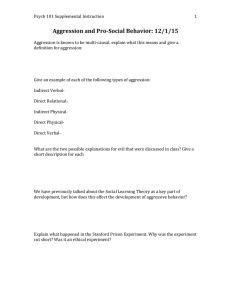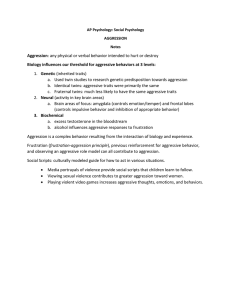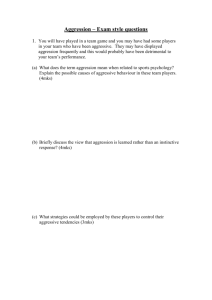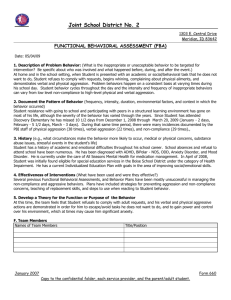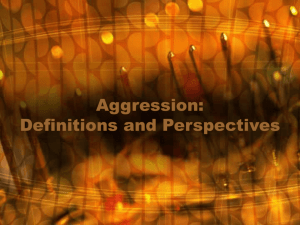Aggressive behavior (Chap 14)
advertisement
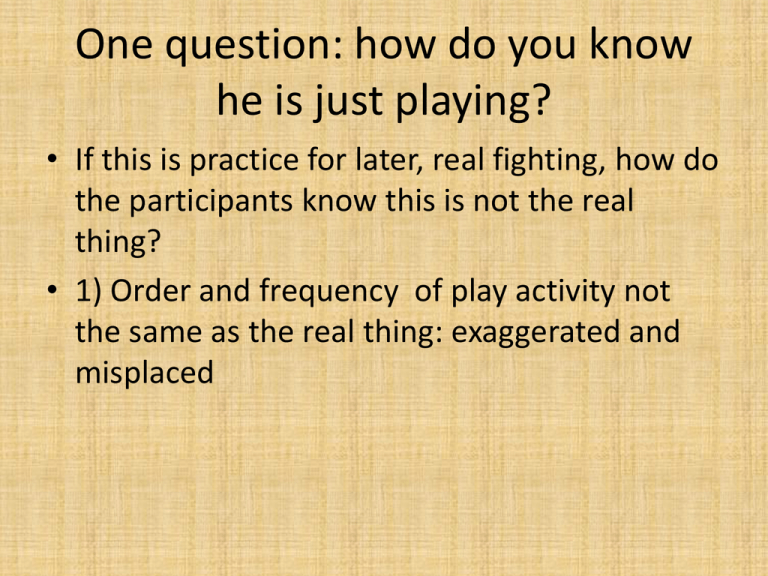
One question: how do you know he is just playing? • If this is practice for later, real fighting, how do the participants know this is not the real thing? • 1) Order and frequency of play activity not the same as the real thing: exaggerated and misplaced Not the real thing • 2) Play markers or signals: stereotypic activities designed to signal intent. Behaviors of dogs: pawing, bowing, etc. • 3) Role reversal or self-handicapping - Here what would normally be a dominate individual will take a subordinate role, let the other one “win”. - Letting your little brother “beat” you or he may not play with you! here General theory • Some separate/some overlap. • How about a general theory? • Main function of all play is to develop physical and psychological skills to handle unexpected events were you lose control. - Increases versatility of movements used to recover loss of balance - enhance ability of animals to cope with unexpected stressful situations Summary • Three types of play, based on whether you play with objects, yourself, or others. • Each has some unique functions and common ones • Overall function is to prepare individual, not just for adulthood, but for the uncertainties of adulthood • Increases your reaction capabilities and coping skills. Aggressive behavior (Chap 14) • Not all fun and games! • As mentioned, play gets you ready for adult life, one filled with a lot of aggression Aggressive behavior (Chap 14) • Not all fun and games! • As mentioned, play gets you ready for adult life, one filled with a lot of aggression • Saw it in sexual behavior, especially between males, but can happen between females. • Occurs often outside of sexual context • Besides sexual behavior between male and female, likely the second most frequent behavior type, and is even found in sexual behavior! Aggression or agonistic behavior • Defined: refers to behavior between members of the same species that is intended to cause pain or harm • • • • Again, lets see how we would define it. Violent Resolve conflicts Establish social order • • • • • Warnings Defense of resources Instill fear in others Communication Defend offspring • Excludes predation or predation is a special form of interspecific aggression!?? • Will deal with this later. Classification • Can we classify different types of aggression? • Aggression can be subdivided into types based on intended victim, body postures during aggression, and other factors such as what the animal may want, estrus status of animals involved, and location of the aggressive encounter Classification • In each hints at function, so lets look at this. • supposed function of the aggression can be used as the basis of classification: • Dominance (status related) related, possessive, protective and territorial, predatory, fear induced, pain induced, parental, redirected, play, intermale, interfemale, and pathophysiologic (medical) in origin. Communication • First thing to remember is that aggression is actually a means of communication. • Communicating your emotional state • Communicating your intentions • Communicating your social rank • Etc. Dominance • One of the best known forms of aggression is in establishing social rank. • Solitary animals: territorial aggression. • Social animals: Dominance Hierarchy. • Social rank determined by outcomes of aggression, Alpha male/female, Beta individuals, etc. Factors involved Reasons for aggression • Ultimate implications: • used to resolve competitive disputes over resources (territory, food) Ultimate implications • More access to resources Ultimate implications • Greater survival of young Proximate mechanisms • Testosterone • The hormone of winners! Not just limited to males • Higher testosterone, higher rank • High ranking females more aggressive Proximate mechanisms • Glucocorticoids: hormones related to stress • The hormone of losers?? • Stress hormone, would expect more stress in subordinate individuals • But yet… • Some propose dominance hierarchy way of reducing social stress, everyone knows its place! Not necessarily! Enough stress to go around! • Way of reducing social stress?? • Most cases not • Dominant individuals stressed about keeping dominate status • Subordinate ones stressed because of aggression in dominant ones and because they want to advance! Is it just testosterone? • • • • Wide range of hormones figure in Just starting to unravel it all serotonin plays a role In mammals: low levels linked with high aggression but low status. • In fish: the opposite Overall • • • • Proximate cause of aggression is hormonal Testosterone one we know best Others still working on Exactly how they “cause” aggression?? Evolution of aggression • In aggressive encounters, the outcome depends on the actions of both involved. • There are two possible actions: fight or flee and if your willing to fight, it now depends on what your opponent decides • Similar to cooperation models brings us to game theory as a way of modeling evolution of fighting behavior: betting on other’s action Three prominent models • Hawk-dove • War of attrition • Sequential assessment Commonalities • There is a cost to fighting - opportunity costs (cost associated with not doing something else - physical injury • Includes a variable represents the value of resource being contested. - access to food - access to reproductive opportunities Resource value - Often will value the resource differently. - This sets the stage for level of motivation to fight or not. - If your hungrier, you may fight harder than if your not. Hawk and dove • Game theory model proposed by Maynard Smith and others in the 70’s-80’s • Setting: individuals can adopt one of two behavioral strategies when faced with possible aggressive situation Hawk and dove model • - Hawk: player will continue to escalate until it either is injured or the opponent gives up. • Like poker, the person who will always raise the bet. • - the Dove: player will attempt to escalate but will retreat and give up if opponent escalates • Poker: the person who is “bluffing”! Conditions (stakes) • • • • • • • V = value of the contested resource (the “pot” C = cost of fighting (what you have to lose) Envision 4 possible combinations Hawk-hawk Hawk-dove Dove- hawk Dove-Dove here Combinations and outcomes Dove Hawk Easiest: hawk-dove - Hawk wins (V – C)/2 Hawk V 0 (V – C)/2 V/2 0 Dove V V/2 Dove-Dove? Dove Hawk • Assume each “wins” half Hawk the time • No cost because other leaves. Dove (V – C)/2 V 0 (V – C)/2 V/2 0 V V/2 Hawk-hawk? Hawk • -only loser pays the cost. • 50% chance Hawk of winning • 50% chance of paying cost (injury) (V – C)/2 V 0 (V – C)/2 V/2 0 Dove V V/2 What is evolutionary stable strategy? • • • • • Depends on relative value of V and C If V > C, then being a hawk is the ESS. Hawk meets dove, hawk wins Hawk meets hawk, win ½ time Only time dove wins anything is when it meets another dove, ¼ of the time this happens! • Reason: Price paid (C ) is low compared to V and you only pay it if you loose! ESS • IF V < C, becomes more complex • Now not necessarily beneficial to be a hawk in a hawk world. Price of fighting not worth the cost, which you will pay ½ the time! • Now some combination of hawks and doves becomes the ESS. Real animals? • If value of resource is high, e.g. mating opportunities, we can see how aggression would be selected for. Fighting over the resource is only way to win. • If resource value is low, not worth fighting for, better to be a dove. • Example of speckled wood butterflies. • Resource: open forest patch • If you come across a territory that is occupied, you leave. • Only a hawk If you have territory. Why? Resource patch ephemeral, why fight ever it. Another example • Case: when value of resource might be high but resource is not limited. • Here inherent value might outweigh cost BUT relative value/availability becomes low. • Mexican spiders: establish territory but if intruder comes, they leave rather than fight. Costs less to go and find new territory than to fight. Rules of engagement • So not just a model on how aggression might arise in a population. • Model for decision making as to when to be aggressive or not • Determining factors are V and C. War of Attrition model • Often aggressive interactions settled by displaying rather than fighting • One who displays the longest wins • For this type of aggressive encounters, we can use war of attrition model. • War of attrition scenarios refer to the situation where fighters attempt to grind down the opponent's defenses. There is no fixed cost associated with losing or contesting, but as the encounter wears on, each player accumulates incremental costs. A decision to give up arises when one individual backs down, relinquishing access to the contested resource, rather than continuing to sustain further insults Model assumptions • Three assumptions. • 1) individuals can choose to display aggressively for any duration of time. • 2) Display behavior is costly, the longer the display, the more energy expended • 3) no clear cues such as size, territory, etc. that contestants can use to settle a contest Let the game begin • Basic standoff situation, the first one to blink loses. • If V = value of resource and C is cost, what is the length of a contest involving displays (x)? • How long do you remain engaged in this? • Basically depends on V because cost is equal between the two. Probability of length of display? • Instead of asking how long they should stay, we can ask, what is the probability of them staying a given x length of time. • • At the ESS, the probability that a contest lasts x units of time = (2/V) e-2x/V • Ok…. Visually • Three different values of V, calculate probability of each x via: • (2/V) e-2x/V • Longer x, less probability. Higher possibility contest lengths will be short. Who’s blinking and why? • Said that costs to display should be equal but why would one give in so often at a low contest length?? • Basically how much are you willing to pay? • Prior experience, food resources for example, how hungry you are! • Seems to be some support of this in the wild. Sequential assessment model • Model to realistically analyze how animals fight. • Authors felt other game models not based on realistic behavioral mechanisms. So much behavioral diversity in fighting behavior cannot be analyzed with them. So how is it different? • Designed to analyze fights where individuals continually assess each other via series of bouts or mini fights. • So how does model attempt to do this? Assessing opponent’s ability • Authors argue similar to statistical sampling. • One “sample”, a “bout” gives the individual an idea BUT is prone to random error (how realistic is it?) • Increase the sample, reduces the error rate and have better idea of the “mean” fighting ability Once you sampled! • Once you have sampled sufficiently, you now can gauge your opponent’s ability against yours. • If your chances of winning are low, you leave • If your chances are high, you fight in ernest! Sampling process • So how should you go about sampling fighting ability? • Obviously different levels of aggression/ fighting = costs. • So, start out with the lower levels and gradually work to higher, more dangerous levels, until one gives up • More similar they are, the more aggressive the behavior Sequence • This model also predicts that if there are numerous behaviors, they should be used in the same sequence across all fights. • So if #1 is lowest and #2 progressively more, etc. • #2 should always follow #1, #3 - #2 etc. • Until one breaks away. • Only the length of contest and thus number of behaviors will change. Evidence for this? • • • • • • • Sounds good but is there support for it? Mixed support Best is with fighting fish. Males form hierarchies Range of aggressive behaviors Color changing (lowest) To circling to bite each other (highest) The study • Videos of encounters to see how far each would go based on respective rank. • Seem to match prediction. 1) More evenly matched, the longer and more escalated the fight. 2) Sequence was the same every time. Summary of the three models • Each designed to model different aspects of aggressive encounters. • Designed to predict how aggressive behavior might evolve. • Rules of engagement, when should you fight, • With whom you should fight, • How to avoid physical combat or at least more dangerous encounters Summary • Evolutionarily designed to increase your access to resources, without getting killed! • Does result in winners and losers Winners, losers, and others! • Can ask how winning or losing may affect your performance in future encounters. • Also what is the effect on those that are watching? (bystanders) • Lastly, what effect does the audience have on encounter outcomes?? Winner and loser effects • Know that in sports winning or losing can influence how well you do the next time (pumps you up or breaks your self confidence) • Similar in animals: winner effects: If you win an encounter, probability you will win the next is higher. And visa versa. • Why? Winners and losers • Losers seem to have more glucocorticoid stress hormones for a longer time after the fight. • Testosterone levels related to winning and losing Evidence? • Lots of field evidence: Blue-footed boobies Snakes • Copperhead snakes Mice • Fig. 4. Testosterone and Corticosterone levels across the five conditions. Testosterone increases significantly in males that win more than two previous encounters compared to controls, and in male winners that win three previous encounters compared to male winners that have won zero previous encounters. Bystander effects • Ok, lots of support for winner and loser effects • How about bystanders? • What affect does seeing another win or lose have on YOUR chances of winning or losing? • What does watching give you? Interspecific aggression • Predators against prey but • Non-predator situations.

